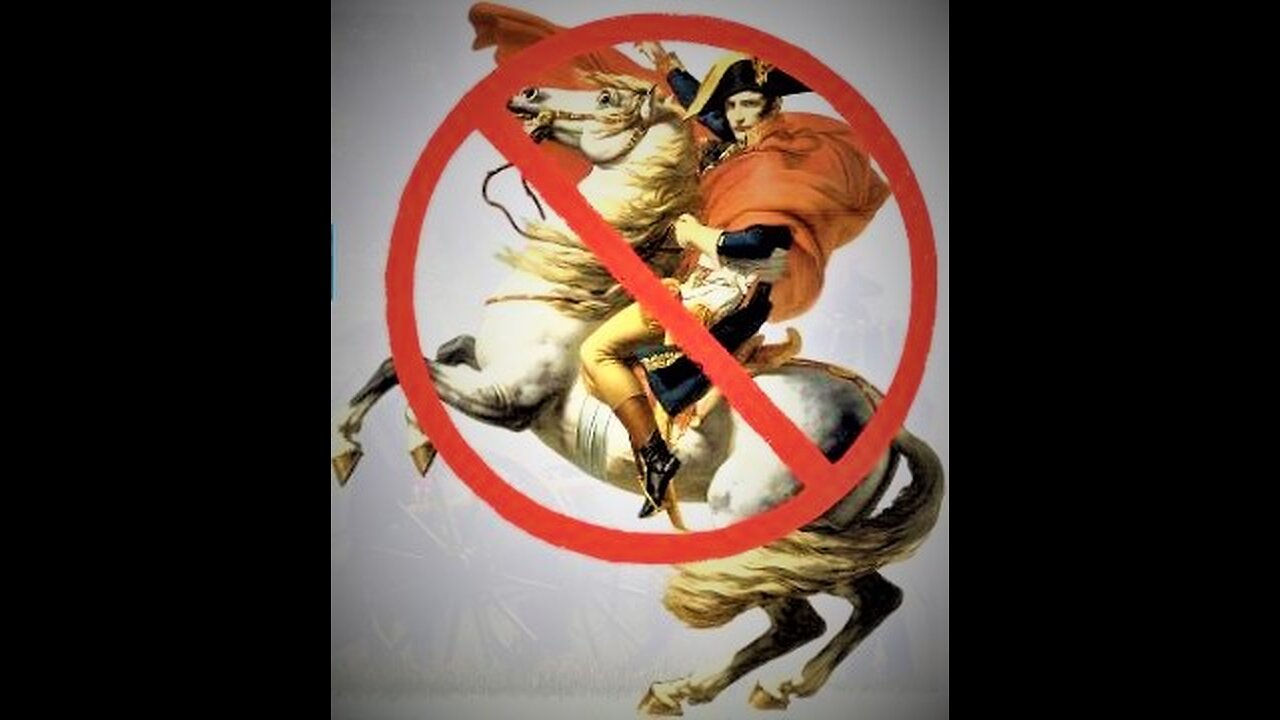Premium Only Content

COVERT SATANISM: 19 WHITE SUPERSTITIONS (HIS-STORY)
Napoleon didn't exist, is only a myth
Probable non-existence of Napoleon is the subject of a pamphlet written in 1819 by Richard Whately (1787 – 1863).
Whatley was a renowned English logician and theologian, later to become Anglican Archbishop of Dublin.
The wording in the heading above is actually not the original title of the pamphlet. Rather, it’s a re-translation of the title of a foreign-language translation of Whately’s pamphlet.
The original English title of Richard Whatley’s pamphlet was Historic Doubts relative to Napoleon Buonaparte. But the main idea remains the same, irrespective of its wording.
Whately’s text (25-odd pages) represents a masterful feat in the art of casting doubt on something that almost everybody considers as an indubitable fact.
Whatley’s argumentation is similar to the reasoning of present-day Holocaust deniers. The analogy is compelling, considering that Napoleon was still alive on St Helena when the pamphlet was written in 1819, and that today many first-hand witnesses of the Holocaust still live in the midst of our societies.
An anaemic list from an entertaining pamphlet
At base bottom, Richard Whately had a different axe to grind than refuting Napoleon's existence (more of this later).
But he did a jolly good job of demonstrating Napoleon's non-existence nevertheless.
Some of his arguments in condensed form. Such a list is unfortunately bound to look rather anaemic and lacklustre – you'll have to imagine how the arguments were elaborated in the pamphlet, with all of the considerable rhetorical skill that the future Archbishop of Dublin possessed. Whatley’s pamphlet should be required reading for all conspiracy-theorists, current and future.
Scepticism galore
So here are some of Richard Whately's historic doubts relative to the existence of Napoleon :
Napoleon's existence is taken for granted, without controversy. But this very circumstance draws off attention from the matter of its credibility. It becomes more likely that insufficient evidence is accepted and flaws in the evidence are overlooked. There are many examples of how flaws in supposedly uncontroversial ideas were overlooked in the past, e.g. flaws in the idea that the Earth was flat.
Most people who are convinced of Napoleon's existence have never seen him. They base their convictions on mere hearsay.
(Those who say that they saw Napoleon in Portsmouth, on board the Royal Navy ship that was to despatch him to St Helena, can not positively say that they saw Napoleon – they only saw a person at a distance, with a special hat.)
The entire story of Napoleon and his fantastic exploits is completely unbelievable. People who say that they have met him or have been personally involved with him seem to be aware of this.
They usually introduce their improbable account by phrases like "I would not have believed such a thing, if I had not seen it." Then why should we believe it?
Most of the stories about the exploits of Napoleon emanate from newspapers, which are chronically unreliable (you read retractions and corrections of past articles almost every day). On top of that they were not even eye-witness accounts, but came from "private correspondents".
The stories about Napoleon's exploits that the "private correspondents" transmitted, had normally passed through a whole chain of people, from the original "eye witness" to another person, then to yet another, and so on, until it was finally told to the "private correspondent". An account, as told by one person, may be 90 % correct. But if it is passed through a chain of 20 people (each time with a 0.9 probability of being correct), then, the probability of the last account being correct is less than one eighth (according to La Place: Essai Philosophique sur les Probabilités, to which Whately refers).
The achievements of Napoleon Buonaparte, as told by the papers, are truly wonderful and exciting. Wonderful stories attract many readers and sell many copies. Hence it is hardly in the interest of the newspapers to care whether the stories are true or false.
For the British government the idea of a threatening Napoleon-figure served as a politically potent instrument for raising taxes, obtaining funds, and getting its proposals smoothly through Parliament. The period was long enough for different parties to head the government, so it was in the interest of both parties to perpetuate the Napoleon legend.
There are overwhelming amounts of factual discrepancies in the stories of Napoleon's exploits. Some say that Napoleon led the celebrated charge over the bridge of Lodi in person, others that this was done by Augereau. The charge of the French cavalry at Waterloo is likewise described in contradictory ways. Here even the different accounts of the hour of the battle disagree by as much as four hours. The battle of Borodino is paradoxically claimed as a victory by both sides. Etc., etc.
The character of Napoleon is described in very different terms by different observers. To some he is a wise, humane hero, to others a monster of cruelty. Some see him as a military and political genius, others as a madman. This may point to the figure of Napoleon being a mythological composite of several actual individuals, like many of the ancient Greek and Roman mythological heroes.
The French king in 1819, King Louis XVIII, is a Bourbon king and claims to have been king of France for 23 years. During this time France and England have fought many battles. This makes it quite probable that the figure "Napoleon" is actually a mythological composite of many different French heroes from many different contemporary battles between England and France.
Argument against theological revisionism
In Richard Whatley's pamphlet there is much more, all of it cleverly elaborated and highly entertaining, and all of it pointing to the conclusion that Napoleon Bonaparte (whom Whatley prefers to call by the Emperor's Corsican surname Buonaparte) never existed.
However, Whatley's purpose was hardly to prove the non-existence of Napoleon Bonaparte. His pamphlet is rather an argument of sorts in a theological debate that was going on in England at the time.
David Hume’s philosophical scepticism had carried over to theology and in the early 1800’s a book, Historic Doubts Relative to Jesus of Nazareth, was published, featuring a "refutation" of the historical existence of Jesus.
Richard Whatley's intention with his "proof of the non-existence of Napoleon" was simply to demonstrate the absurdity of sceptical argumentation in absurdum.
It could be that some Holocaust "revisionists" might benefit by reading Whatley's pamphlet. But to my mind, most of them unfortunately seem to be beyond all reasonable hope of ever becoming reasonable.
Reference:
http://richard-whately.biography.ms/
http://www.nd.edu/Departments/Maritain/etext/mamt04.htm
http://elvis.rowan.edu/~kilroy/CHRISTIA/library/doubts-napoleon.html
Your entire life is an illusion: New test backs up theory that the world doesn’t exist until we look at it:
Quantum mechanics states reality doesn't exist until it's measured
This means a particle's past behaviour changes based on what we see
Experiment using an atom and laser beams has proven this to be true
How the atom behaved depended on how it was measured at end of test
Now, physicists at the Australian National University have found further evidence for the illusory nature of reality. They recreated the John Wheeler’s delayed-choice experiment and confirmed that reality doesn’t exist until it is measured, at least on the atomic scale.
La realidad es una ilusión, el universo es un holograma.
(Bill Cipher)
Metaphysical solipsism: is the strongest variety of solipsism. Based on a philosophy of subjective idealism, metaphysical solipsism maintain that the self is the only existing reality and that all other reality, including the external world and other persons, are representations of that self, and have no independent existence.
When Socrates 2400 years ago stated his famous "I know that I know nothing" he didn't really know how right he was. We know each time less. Some actual experiments show that reality is created when observed, that the past behavior of particles can change based on what we see. So the past can be past or only a myth.
Would be then strange that in 1000 years Napoleon is seen as non existing and only one more of the myths related to the sun? In fact we know it already but is nicer to believe Napoleon existed really.
Let's see:
.- His name was Napoleon Bonaparte
.- Was born in an island of the Mediterranean Sea
.- Mother's name was Laetitia
.- Had 3 sisters and 4 brothers, 3 of them were kings
.- Finished one revolution
.- Had 16 Field Marshals, 12 in active service
.- Was glorious in the south and succumbed in the north
.- After 12 years ended in the western seas.
1.- Poets (and not only) call the sun Apollo (in French Apollon). Apollo is the same as Apolleon and derives from the Greek verbs apollou / paoleo that mean, kill, lose, exterminate. Is clear that Napoleon "killed" "exterminated" people in his wars. Note the complete similarity between Apolleon and Napoleon, the difference is the "N", but this is again Greek where ne, nei is one of the biggest affirmations. This means that we would speak about the real, the important, the true Apolleon, the true Sun.
What about the family name? Bonaparte. Means good part- He is the good part. Something related with the sun has two parts ... what? the day, light and darkness; darkness that disappears when the sun is present. What do we have? The true sun that illuminates, that is the good part of the day, that kills darkness and enemies.
Seems we follow the right way. Let's continue...
2.- Napoleon, like Apollo was born in an island. Corsica, close to France like Delos was also close to Greece. Pausanias tells that Apollo was in fact a Egyptian god (born out of Egypt and adored there as such). Napoleon was also considered as a special man, friend of Muhammad the prophet and was even adored in some places.
3.- Mother's name was Laetitia, that means joy, but is clear that under this name is referred the sunrise, the joy of the day. Leto was the name of Apollo's mother, converted into Letona by the Romans. The name evolved to Laetitia. Leto gave birth to Apollo and disappeared practically after. Also the sunrise vanishes when Apollo grows and Napoleon overshadows the mother.
4.- Napoleon had 3 sisters and Apollo also: the Kharites (Charites or Graces) daughters of Zeus.
5.- Napoleon had 4 brothers from which 3 were kings. And Apollo? well it is clear that the 4 brothers have to be the 4 Seasons. Three Kings: Spring, that reigns over the flower, Summer that reigns over the harvest, Autumn that reigns over the fruits. They reign by the grace of the Sun, so is clear they got the power from Apollo. The fourth brother, Winter doesn't reign over anything.
I could be argued that Winter can be considered the Principality of Ice, Snow and Cold. This in only one more point to compare to the Principality of Canino given to one of the brothers. Precisely Canino derives from Cani the white hair typical from the old, sad age that is considered the winter of life. Poets compare since at least Roman time the white hair with the snow on the trees: "Cum gelibus crescit canis in montibus humor".
6.- Apollo killed the Piton, a snake that terrified humans and animals. Napoleon ended with the French Revolution that was called the Hydra of France. But Hydra is a mythical snake of 7 heads, at the end a powerful snake and Napoleon ended with it. Moreover, Napoleon ended with the snake of the revolution and revolution derives from revolvo which is coiled, so the piton snake.
Seems that we find too many parallelisms to be just a mere coincidence, no? Let's continue ...
7.- The 12 Field Marshals of Napoleon are clearly a reference to the 12 signs from the Zodiac and the 4 inactive are the 4 cardinal points that observe the movement of the other 12.
8.- Napoleon was winning in the South, had problems in the North. This happens also with the sun that covers well the South but has to withdraw from the North for some months.
9.- The sun rises in the east and dies in the West. We can say that is rises in the oriental sea and dies in the Western sea. Napoleon came from the East to reign over France and died in the western sea, after being 12 years ruling the country. What are these 12 years if not the metaphoric 12 hours of the day that the sun is showing his power during the day on the horizon?
It is clear we have taken as history part of the mythology. All describes only the sun moving around the earth as it was thought in ancient times!
It is evident: reality doesn't exist, we create / invent reality when we look to what we observe. And if reality does not exist and we create all when we observe, then is clear that napoleon existed or not depending you read this text or not. And if you do... you may modify the past and can be this text was created only for your eyes... or not.
=======
Ah, Napoleon. People can’t get enough of this guy. The man. The myth. The legend. Actually scratch that first part.
Was Napoleon really a man?
You might think that’s a crazy question.
It’s taken for granted that Napoleon existed. But this very circumstance draws attention away from the credibility question.
We often are likely to accept insufficient evidence and ignore flaws in the evidence when things go unquestioned.
Flaws in supposedly uncontroversial ideas have been overlooked in the past, such as flaws in the idea that the Earth is flat.
History books may tell us one thing, but increasing numbers of independent researchers are questioning whether Napoleon existed at all. Yes, you heard that right. Let that sink in.
So what do the history books tell us about Napoleon?
Time doesn’t allow for me to get into the so-called miraculous military exploits of this “average for his height for the time” commander.
There are dozens of other websites and videos spreading the traditional propaganda found on YouTube and so-called history channels. But here’s his bio in a nutshell:
Napoleon Bonaparte was a French general and emperor during the early 19th century. While serving in the French army during the French Revolution, Napoleon ascended rapidly through the ranks.
In 1804 he crowned himself emperor after seizing political power in France in a coup d’état in 1799.
Napoleon was an ambitious, skilled, and shrewd military strategist who waged war quickly and successfully against various coalitions of European nations and expanded his empire.
Napoleon abdicated the throne, however, two years after a disastrous French invasion of Russia in 1812.
After being exiled to Elba, he managed to easily escape and regain control of France again, practically miraculously.
During his Hundred Days campaign in 1815, he briefly regained power. After being crushed at Waterloo, he was exiled to the remote island of Saint Helena, where he died aged 51.
Some say it was from being poisoned, although others have said it was stomach cancer.
No one on the planet has actually seen his body, though.
The Incredible Shrinking Napoleon
Why do more researchers doubt the existence of the so-called most amazing military mind in French history? Well, here we go:
A large majority of contemporaries who are convinced of Napoleon’s existence have never actually seen him.
Their convictions are based solely on hearsay. (People who claimed to have seen Napoleon in Portsmouth, onboard the ship that was to leave him on St Helena, can’t be sure they saw him; they only saw a person at a distance, wearing a funny hat.)
Napoleon and his fantastic exploits are completely unbelievable. Many people who said they have met him or know him said things like “If I had not witnessed it, I wouldn’t have believed it.” Then why should we believe them?
Most stories about Napoleon’s exploits originate in newspapers, which are notoriously unreliable (you read retractions and corrections of past articles almost daily). If it is hard to trust the news now, how much more over a couple of hundred years ago?
On top of that, the accounts didn’t even come from eyewitnesses, but from “anonymous correspondents”. Seems legit.
There’s also the whole telephone game problem:
The stories about Napoleon’s exploits that the “anonymous correspondents” transmitted, had normally passed through a whole chain of people, from the original “eyewitness” to another person, then to yet another, and so on until it was finally told to the “anonymous correspondent”.
An account, as told by one person, maybe 90% correct. But if it is passed through a chain of 20 people (each time with a 90% probability, just to be generous, of being correct), then, the probability of the last account being correct is less than an eighth! I wouldn’t bet on that, would you?
Fake news
Let’s look back at newspapers from those days. Compared to today, they weren’t much different.
They were just as much of a business back then as they are now.
The goal of their reporting is to attract eyeballs, not to report facts objectively.
What the papers told us about Napoleon are what we would call today clickbait. An epic story attracts readers and sells copies. Especially when it can’t be verified as we can with cameras now.
Let’s be real, the fact that the stories are true or false wouldn’t matter all that much to newspaper reporters back then.
That’s just the newspapers, let’s think about the government.
For the British government, Napoleon was a bogeyman for raising taxes, securing funds, and ramrodding its proposals through Parliament.
Both Whigs and Tories both had a vested interest in spreading the Napoleon legend during this period when different parties held power.
A world of contradictions
Finally, Napoleon’s exploits are riddled with contradictions. According to some, Napoleon led the celebrated charge over the bridge of Lodi in person, whereas others say Augereau did it.
Well, it can’t be both! Similarly, the French cavalry charge at Waterloo is described in contradictory ways.
Various accounts even differ by four hours regarding the hour of battle. Paradoxically, both sides claimed Borodino to be a victory.
Depending on which version you read, you get a different story every time!
Worse still, different observers describe Napoleon’s character in very different ways. Some see him as a kind, gentle hero, while others see him as a cruel monster.
He is liked by some because he is a military and political genius, while others think he is a lunatic.
Therefore, it seems more likely that Napoleon represents a mythological composite of several actual individuals, such as many mythological heroes in Greek and Roman mythology.
In fact, King Louis XVIII, the French king of 1819, was a Bourbon king and says he ruled France for 23 years! Do the math! France and England have fought many battles during this period.
The figure “Napoleon” probably is also a mythological composite of many different French heroes from various conflicts between England and France in the past. And the story of Napoleon going into exile on an island not only once but TWICE is clearly an example of a “doublet”.
The island is symbolism for England, Napoleon’s enemy, while his escape represents the mythical trope of the hero escaping the realm of the dead.
It’s also hard not to notice the striking similarities between the Iliad and the Aeneid and the life of Napoleon. Just like Achilles and the Greeks, and Aeneas and the Trojans (who were the ancestors of the Romans), Napoleon’s exploits seem to be magnified in order to glorify his conquerors.
In the same way, Hector is allowed to win battles while Achilles is away, only to make his eventual defeat at the hands of Achilles all the more impressive.
These similarities should raise some red flags for anyone reading Napoleon’s history with a critical eye. Even if the story weren’t filled with so many improbabilities, this alone would make any sharp critic skeptical.
It’s best to withhold judgment until much stronger evidence (which is lacking in this case) can be produced.
So what does the physical evidence about the NAPOLEON tell us? Well, as far as I’m aware, there is NO PHYSICAL EVIDENCE. There’s only a story and testimonials. Testimonials about “hey, so-and-so saw this” or “this is what happened.”
If THE NAPOLEONIC WARS are true, then it must be the single most important fact in the history of France. And for that fact, we have nothing but HEARSAY!
So there you have it, folks. There was probably no Napoleon.
It’s vastly more reasonable to believe Pedro was class president than to believe an epic person like Napoleon ever ruled France.
https://www.youtube.com/watch?v=J_TiRtqXGYo
Tartaria - Napoleon and the Mud Flood: English eBook
https://www.amazon.com/Tartaria-Napoleon-Mud-Flood-English-ebook/dp/B0BJ7TWYJL
How Napoleon went from ‘cannibal’ to ‘Majesty’ in 20 days
Alexandre Dumas' famous anecdote about Fake News in the 1800s has a surprising twist
Napoleon's victory march to Paris, and the effect it had on Parisian headlines - mapped for the first time ever
https://bigthink.com/strange-maps/napoleon-cannibal-majesty/
Unfazed by his first defeat, Napoleon swept back into power in 1815, going from exile to emperor within a single month.
Parisian newspapers scrambled to adapt:
at the start of that month, Napoleon was a 'cannibal'; at the end, 'His Majesty'.
For the first time ever, this map illustrates the spatial dimension of that shift – but the anecdote, made famous by Dumas, has a twist.
1 March 1815:
Napoleon lands at Golfe-Juan
In French history, the period from March 1 to March 20, 1815 is known as Le Vol de l’Aigle:
the Flight of the Eagle. The Eagle, of course, is Napoleon – the diminutive Corsican whose political and military genius had propelled him to become Emperor of France, and conqueror of much of Europe.
But at the start of 1815, Napoleon’s glory days were behind him. Defeated by a coalition of European powers, he had been exiled to Elba, a small island off the Italian coast. In France, the monarchy had been restored.
On the throne sat a brother of the king who had been executed in 1789. It was almost as if the French Revolution – and the Napoleonic Wars – had never happened.
That state of affairs proved insufferable to Napoleon, who could not content himself with ruling over Elba.
On February 26, with a small band of loyal soldiers, he set sail for France in L’Inconstant, a brig disguised as a British ship. Just after noon on March 1, Napoleon landed at Golfe-Juan.
Choosing a route north that avoided the Provence’s most royalist regions, Napoleon and his army reached Grenoble in a mere six days. Having made it this far, Napoleon grew more confident of his gamble:
“Before Grenoble, I was an adventurer. After Grenoble, I was a prince.”
Known today as the Route Napoléon, the once and future Emperor’s fabled mountain road from the coast to Grenoble is fringed with gilded eagle statues.
As its quick advance proceeded north, the ranks of Napoleon’s army swelled with defectors from the very same royalist forces sent to arrest him – often, these were veterans of Napoleon’s battles across Europe, and their fierce loyalty to their old commander trumped their present duties in service of the king.
In Lyon and many other towns, the streets were lined with crowds equally nostalgic for the heydays of Empire.
Riding a wave of popularity and speeding like lightning, Napoleon swept all before him.
Without a single shot being fired, he reached Paris on March 20. The king had fled the country. Napoleon was Emperor again… for just about 100 days.
On June 18, he suffered his final defeat at Waterloo. Four days later, he abdicated. On July 8, Louis XVIII regained his throne.
Following his failed comeback, recorded in Napoleonic lore as Les Cent-Jours, Napoleon was sent into exile again.
This time to a much more isolated island:
St Helena, in the middle of the South Atlantic Ocean, where he would die in 1821.
In Une année à Florence (1841), Alexandre Dumas (pictured by Nadar in 1855) took a critical look at the attitudes of the Parisian press to Napoleon’s
In 1841, Alexandre Dumas père published a travelogue called “Une année à Florence” (‘A year in Florence’).
It contained a reflection on the believability of newspaper headlines, based on the reports on Napoleon’s return to power in the Paris-based newspaper Moniteur Universel in March 1815.
As the official journal of the French government, that paper was hostile to Napoleon, at least when he started his campaign.
Dumas notes that the attitude shifted as the deposed Emperor approached the seat of power:
“If you want to follow his victory march to Paris, you only have to consult the Moniteur. To guide our readers in this historical research, we will provide a rather curious sample.
Step by step, it represents Napoleon’s march towards Paris and shows the change his advance produces in the attitude of the newspaper.”
Dumas then lists ten headlines which prove his point. Below are the original French headlines, plotted on the map are the English translations.
For the first time ever, this map provides a spatial dimension to the shifting attitudes of the Moniteur.
Dumas concludes: “This is the ultimate monument to journalism. It need not do anything else, for it won’t do anything better.”
For the first time, a map that shows Napoleon’s lightning march to retake power in Paris, and the headlines that accompanied him there
The Moniteur Universel was known as le journal de la pensée officielle, i.e. the record of ‘official thought’. Perhaps not so different to the ‘mainstream media’ of today. In fact, some have drawn parallels between the Moniteur‘s initial dismissiveness of Napoleon’s return, and the U.S. media’s inability to comprehend Trump’s march to victory in 2016.
For that reason, and to illustrate the larger point that truth and journalism should not be mistaken for each other, the Dumas anecdote is regularly dusted off.
However, the story has another layer – and a two other important lessons about journalism.
Lesson number one:
Check your sources.
The entire run of the Moniteur Universel can be consulted online via the French National Library, including the relevant daily editions from March 1-20, 1815. They do not contain the titles that Dumas uses.
In fact, as the journal of record, the Moniteur mainly published decrees, statutes and ordinances – nothing quite as lurid as the headlines quoted by Dumas.
In Les Cent-Jours: Légende et réalité (1983), French historian George Blond after extensive research is forced to conclude that “although the Emperor was insulted and dismissed as an adventurer or evildoer in some newspaper commentaries, this legendary series of newspaper headlines never did exist.”
Of course, that won’t stop the Dumas anecdote from resurfacing. And that second lesson is perhaps the ultimate one this anecdote can teach us about journalism:
that the media – mainstream or otherwise – can’t resist a good story.
In the words of newspaperman Maxwell Scott in the John Ford western “The Man who Shot Liberty Vallance: “When the legend becomes fact, print the legend.”
Many thanks to Carrie Osgood, who produced the map to complement Alexandre Dumas’ anecdote. The map is available for purchase on her online store in two versions, the basic map (as shown above) and the map with the story (as shown below).
Strange Maps #1050
Got a strange map? Let me know at strangemaps@gmail.com
UPDATE: For more on the press landscape in France at the time, check out this episode of The Siècle, an excellent and erudite podcast about France’s stormy century from 1814 to 1914. The episode includes the fascinating story of Le Nain Jaune (‘The Yellow Dwarf’), the satirical magazine that published a joke about Napoleon’s changing nomenclature, which eventually grew into the fake headlines as presented by Dumas.
========
The Kings who never were: the living heirs of Europe's abolished monarchies
Tsar Nicholas II of Russia (left); Kaiser Whilhelm II of Germany (middle); Napoleon Bonaparte of France (right)
Tsar Nicholas II of Russia (left); Kaiser Whilhelm II of Germany (middle); Napoleon
While the UK is celebrating its new king, many other European countries haven't had a monarch in over 100 years. But all of them do have people with claims to the throne.
https://www.youtube.com/watch?v=RJw7CudBK30
The death of Queen Elizabeth II ended one of the world's longest apprenticeships and saw Charles III ascend to the UK throne. To many outside the country, the focus on the succession of its constitutional monarchy may seem alien. Across the 19th and 20th century, most European countries took steps to abolish their monarchies permanently.
Just 12 nations in Europe retain a form of monarchy to this day.
They are Andorra, Belgium, Denmark, Liechtenstein, Luxembourg, Monaco, the Netherlands, Norway, Spain, Sweden, the Vatican and the UK.
In all of the countries with abolished monarchies, there are still descendants of the final monarchs.
These people go about their lives knowing that if the hand of history dealt them different cards, they’d be in a similar position to the newly anointed King Charles III in the UK.
Here’s a list of the European monarchs who never were.
Also, fun fact, almost all of these would-be regents are related to the UK’s Royal Family if you go back far enough.
Albania
The last king of Albania was also the second king to some degree. While the medieval Kingdom of Albania did have monarchs, by the 20th century that had been long disestablished.
During the last century, there were two times Albania had a king. The first was just before the First World War after Albania’s independence in 1912 which lasted until 1924.
The second time was when President Zog established himself as king in 1928 which lasted until Italy invaded in 1939.
Today, Zog’s grandson Leka II is the remaining heir to the throne. He has worked as a diplomat and a political advisor to the President.
Austria-Hungary
The dismantling of the Austro-Hungarian Empire in 1918 was the direct result of its loss in the First World War.
After Franz Ferdinand’s assassination in 1914, Karl I became the heir to the throne and assumed it in 1916. His grandson, Karl von Habsburg is alive today and the natural heir to the past-Empire.
Karl has served as an MEP for Austria and has hosted an Austrian TV show called ‘Who is Who’.
Franz Ferdinand and his wife Sonia (left); Karl von Habsburg (right)AP Photo
Bulgaria
Bulgaria held a referendum to abolish its monarchy in 1946 with 95.6 per cent of people voting in favour. At the time, the reigning Tsar Simeon II was forced to leave the country.
Amazingly, Simeon II is still alive making him one of two people on this list who were the reigning monarch themselves. Simeon II was just six years’ old when he took over from his father in 1943.
Alongside the Dalai Lama, they are the only living heads of state from the Second World War.
It’s not been a bad career for Simeon II though, who returned to Bulgaria, became a politician and was the country’s Prime Minister between 2001 and 2005.
The Queen: a life in front of the camera
France
So here’s a bit of a complicated one. There are four different people that lay some claim as the heir to the French throne. That’s largely because the process of getting rid of the royal family in France was one of the messier ones.
The first person with a claim is Louis Alphonse de Bourbon or Louis XX. He’s the direct heir to the throne of Louis XIV who died in 1715.
The problem is Louis XX is related to Louis XIV through his son Philip V who renounced his right to the French throne and became king of Spain. Which makes Louis XX also a potential heir to the Spanish throne.
But that’s complicated as his grandfather Infante Jaime renounced his right.
Louis XX is also not the only heir because after the French Revolution in 1830, Charles X was deposed and replaced by Louis Philippe, Duke of Orléans, his cousin. This started the short-lived House Orléans monarchy, whose eldest heir is Jean, Count of Paris, or Jean IV
Prince Charles-Emmanuel de Bourbon-Parme, descendent of Louis XIV, left, and his son, gathered in Paris to commemorate the exact moment when King Louis XVI was executed
But that’s not all. House Orléans was then overthrown 18 years later in the French Revolution of 1848.
Taking over from the Orléans was Louis-Napoléon Bonaparte, the nephew of Napoléon.
Napoléon had been Emperor before the previous two revolutions and he also has some heirs of his own.
Napoléon’s oldest living heir is Charles Napoléon, a French politician. But even he’s not clearly the heir apparent, as his father stipulated in his will that he wanted his grandson to succeed him as head of the Napoléon house.
That makes Jean-Christophe Napoléon that actual heir. Blimey.
It makes The Crown seem like a picnic.
Georgia
Breathe a sigh of relief. Georgia only has two potential heirs to the throne. Georgia lost its monarchy when it became part of the Russian Empire in 1801.
Nugzar Bagration-Gruzinsky is the living descendent of George XII, Georgia’s last king who died in 1800.
David Bagration of Mukhrani on the other hand is a descendent of the Bagrationi family, which has links to an older strain of the Georgian monarchy.
All differences between these two potential heirs to the Georgian throne were put aside when David married Nugzar’s daughter, combining the family lineages.
Germany
So Germany is a bit of a complex one as pre-1918 it had multiple Kingdoms that existed within its empire like Bavaria and Prussia. But to keep things simple, we’ll only look at the pretender to the German Empire.
The final German Emperor was Wilhelm II who reigned until 1918 when a revolution after the First World War turned the region into the parliamentary
Weimar Republic
Wilhelm II’s great-great-grandson is Georg Friedrich Ferdinand.
He’s also the fourth great-grandson of Queen Victoria of the United Kingdom.
Compared to most of the other pretenders, he’s kept a lower profile and enjoys life in his family’s remaining palaces.
Greece
Greece held a referendum in 1973 to abolish its monarch after a period of unrest, making them the most recent European country to give theirs up.
At the time, the reigning monarch was Constantine II and he’s still alive and kicking. He lived in exile before returning to Greece for the 2004 Olympic Games and now lives back in the country.
Italy
Italy wasn’t a unified country until 1861. From then until 1946, the country was ruled by the House Savoy. Italy’s monarchy was abolished after the Second World War partly as a result of the King’s support of dictator Benito Mussolini.
Nowadays, Vittorio Emanuele is one claimant to the throne as the final king, Umberto II’s son. But, contesting that is his third cousin Aimone, who is the great-great-great-grandson of King Emanuele II, who reigned from 1861 to 1878.
Vittorio has been in exile from Italy for most of his life until returning in 2002. He’s courted a fair bit of controversy, declaring himself king in 1969, being accused of murder in 1978 and an imprisonment in 2006 for corruption.
Lithuania
Lithuania and Poland were united into a single commonwealth in 1569 which ended its individual nation status and monarchy for quite a while.
During the First World War, Wilhelm Karl, Duke of Urach who had at different times looked like he could be in line for the throne in Monaco and Albania, in the end became appointed King of the newly independent Lithuania in June 1918.
It didn’t last long though and he was deposed five months later after Germany’s capitulation in the war.
Still, his living heir Inigo is technically in line for that brief throne, though he only visited the country for the first time in 2009 when he was 47.
By Royal appointment - the Queen's cultural likes and dislikes
Corgis and dorgis:
Who will take care of the Queen's beloved pets?
Montenegro
Montenegro lost its monarchy with the creation of Yugoslavia at the end of the First World War in 1918.
Nicholas is the living heir to the first and last king, Nicholas I of Montenegro. Until Nicholas I, Montenegro royalty was a spiritual role and meant the leaders were also bishops.
These Prince-Bishops were called vladikas and were celibate. Nicholas I and his father changed that, and he became the only ever king of the land.
Portugal
The Portuguese overthrew their monarchy in 1910. The final king was Manuel II who had no children. This meant the official line to the throne came from the family tree of King Miguel I, whose living relative Duarte Pio is a politician who advocates for, among many things, monarchies.
Ex-king Manuel II of Portugal with wife Princess Augusta Victoria of Hohenzollern and Princess Henriette of Belgium (left); Duarte Pio
Romania
King Michael I of Romania became the last king when the country formed a communist government in 1947.
Michael I’s eldest daughter is Margareta, who is one claimant to the throne. Her father even designated this, despite it not being an act recognised by the Romanian government.
However, Paul Philippe claims he’s the rightful heir. He claims Michael I shouldn’t have been king as his father - King Carol II - had a child before him with a previous woman. That child is Paul Phillippe’s dad. Even though he recognizes the republic, Paul Philippe got so wound up about this he sued the country to recognize his dad as the son of Carol II.
Complicating things further, due to the rules of succession in 1937 under Carol II, technically Karl Friedrich is the heir to the throne. Though he claims to have no interest in the title.
Russia
One of the biggies. The Romanov Tsars of Russia met an unhappy end. The February Revolution of 1917 saw the family abdicate power before they were executed, likely under orders by Lenin, in 1918.
So many member of the Romanov family were executed as part of the Russian revolution, there was confusion for quite a while as to who was the actual technical successor. Most notable was Anna Anderson, who claimed to be Anastasia, the last Tsar Nicholas II’s daughter
Instead, it’s generally agreed that Maria Vladimirovna or Karl Emichof, the great-great-granddaughter and great-great-grandson respectively, of Emperor Alexander II are the likely heirs.
Alternatively, the son of Nicholas II’s grand-nephew Alexis Andreievich may also have a claim. All three pretenders to the throne have spent a fair share of time fighting over whether they want to be recognised or not.
Serbia and Yugoslavia
Finally, these two can go together as they have the same pretender to their thrones. When Serbia became part of Yugoslavia in 1918, King Peter I of Serbia became King Peter I of Yugoslavia as King of the Serbs, Croats and Slovenes.
In 1945, King Peter II was deposed as King of Yugoslavia and the Socialist Federal Republic of Yugoslavia was created.
His son, Alexander, grew up in the UK and, you guessed it, believes in the restoration of the monarchy.
Napoleon Bonaparte Signed Letter from Polish Campaign, War of the 4th Coalition:
“once they arrive in Berlin … review them, let them rest several days, and give them coats and shoes.”
NAPOLEON BONAPARTE. Letter Signed, in French, signed as “Napol” at the top of the third page
“Monsieur General Clarke, my intention is that the 2nd Italian regiment reports at Kolobrzeg, until the entire Italian division is present; that will permit us to return the 19th of the Line here.
Marshall Kellermann writes me that the 5th, 6th, 7th, and 8th provisional regiments have left. The 5th has been at Kassel a long time.
The 6th must be at Magdeburg, the 7th must have returned by the 5th. The 8th will arrive there the 17th.
My intention is that we leave no one at Magdeburg, and that you direct everyone to Szczecin or to Kostrzyn.”
“Maral Kellermann assures me that they are well armed and dressed. My managerial staff needs reinforcements for these eight provisional regts; I have thus ordered Mal Kellermann to have the last four regiments, that is, the 9th, 10th, 11th and 12th, depart as soon as they are organized.
My intention is that, once they arrive in Berlin, you review them, let them rest several days, and give them coats and shoes. You will do the same thing at Kostrzyn. The 31st Light Infantry must arrive at Berlin.
Direct them towards Szczecin, after giving them a little rest, and reviewing them. I prefer that regiments pass by Szczecin rather than by Kostrzyn, because circumstances can render them exposed, and that they clear a passage from Marienberg to Torun...”
“The 45th of the Line arrives the 14th at Mainz and will proceed directly to Magdeburg. The 3rd Battalion of the 17th of the Line will begin marching March 2nd for Magdeburg.
You will review them. If there are 800 mn, dash them off to this regiment, without leaving them any time at Magdeburg.
The 3rd Battalion of the 21st of the Line will have arrived at Mainz. Ask Marshall Kellermann when he arrives. On this, I pray that God keeps you in his holy care. At Osterode March 11, 1807.”
“Napol.”
Historic Background
Napoleon Bonaparte—emperor, military commander, and master geopolitical strategist—addressed this lengthy missive to his Minister of War, Henri Jacques Guillaume Clarke (1765-1818), in early March 1807, from the last months of the War of the 4th Coalition (October 1806-July 1807), when Napoleon’s forces were marching east conquering modern day Poland. Napoleon won the war after forcing the surrender of Polish strongholds Szczecin in October 1806, Gdansk in May 1807, and Kolobrzeg in July 1807.
Napoleon personally commanded his Grande Armee of up to 1,000,000 soldiers. In this Polish campaign, Napoleon’s French forces joined German, Italian, and Polish troops against the coalition of Prussia, Russia, Great Britain, and Sweden.
As this letter shows, Napoleon was intimately involved in the minutest details; Napoleon berated subordinates if they did not report everything to him. This letter mentions the movements of 15 regiments to and from nine German and Polish cities.
Napoleon relied on General Clarke for inspection and provisioning, conscription and internal discipline. General Clarke was recognized with the title of Duc of Feltre in August, 1809.
Marshall Francois-Christophe de Kellermann (1735-1820) was a career soldier whose resistance against the Prussians at the Battle of Valmy (1792) earned him Napoleon’s great respect.
Napoleon Bonaparte (1769-1821). Born at Ajaccio, Corsica. He quickly rose through the ranks of the French Army to become Commander of the Army of Italy. After he defeated the Austrian army and conquered Italy in 1796, he was given command of the Army of England. Rather than attacking directly, he planned to wipe out her trade in the Indian subcontinent. Sailing from Toulon, he captured Malta, and in early July 1798, he captured Alexandria and advanced into Cairo. However, at the Battle of the Nile on August 1, 1798, the French fleet was practically annihilated by Admiral Nelson’s Royal Navy.
Napoleon secretly returned to Paris in 1799, in time to join in the coup d’état that overthrew the Revolutionary government. He arranged a new constitution, and was to a ten-year term as First Consul.
But, having secured peace with Austria and the Pope, he arranged an election that voted him Consul for life. On December 2, 1804, Napoleon crowned himself Emperor of France.
In 1805, he found himself at war with Prussia, Saxony, and soon Austria in addition to England, causing the fall of The Holy Roman Empire.
He later set off the Peninsular War by sending armies into Portugal and Spain. Napoleon’s “Continental System” was undermined by Russia, which opened her ports to neutral shipping. In June of 1812, Napoleon invaded and attempted to conquer the Russian Empire.
He defeated the Russian army at Borodino in September. However, Napoleon miscalculated the Russian winter, the strength and nationalism of the Russian people and the determination of Czar Alexander I to protect his empire at all costs; to deprive Napoleon’s troops of shelter and supplies, the Czar had Moscow burned.
The disastrous defeat and retreat cost Napoleon more than 500,000 men, of the army of 600,000 he had set out with.
In 1813, Wellington routed the French and forced them out of Spain. Prussia, Saxony and Austria, had allied with Russia, and invaded France and stripped away much of her conquests.
Napoleon was forced to abdicate in April, 1814; he was given sovereignty over the island of Elba, and allowed to retain the title of Emperor.
Within a year, Napoleon returned to Paris, supported by his army and his people. Europe declared war. Wellington’s army in Belgium and Blucher’s on the Rhine joined forces to overwhelm Napoleon at Waterloo.
Napoleon fled to Paris and surrendered in July, 1815. Exiled a second time, the man who ruled Europe spent his last six years on the small island of St. Helena in the South Atlantic. He died there six years later.
His body wasn’t allowed to be repatriated until 1840.
Napoleon instituted political and social reforms that reined in the excesses of the French Revolution, pulled the nation out of bankruptcy, created a fair tax scheme, reorganized the French educational system, and instituted the Napoleonic Code, which provides the precedent for modern French law, combined the basic tenants of old Roman law with ideas from the Enlightenment.
He thus planted the seeds of the modern middle class and created institutions that continue to shape our world.
Condition
On watermarked cream bifold paper in near fine condition, with light paper folds.
Provenance
Ex-Marc-Arthur Kohn, “The Empire in Paris,” December 2, 2013 (Paris, France), part of lot 38.
https://www.bbc.com/news/world-europe-30074931
from THE LETTERS OF NAPOLEON I - SharpSchool
https://cdnsm5-ss12.sharpschool.com/UserFiles/Servers/Server_520401/File/Departments/Curriculum & Instruction/ELA/Non-Fiction Texts/The Letters of Napoleon I.pdf
READING FOCUS:
How do you think the censoring of newspapers, plays, books, and sermons aided. Napoleon? To Citizen Ripault, Napoleon's Librarian ...
https://www.thecollector.com/napoleon-bonaparte-portraits-propaganda-art/
A Portrait of Napoleon Bonaparte as a Work of Propaganda
May 9, 2022 ... One such painting of Napoleon Bonaparte that stands as one of the most representative examples of Napoleon's propaganda as general was done ...
-
 1:25:22
1:25:22
Kim Iversen
16 hours agoThe Real Target Of The LA Protests: YOUR FREEDOMS
71.9K175 -
 9:00
9:00
Adam Does Movies
13 hours ago $0.18 earnedBallerina Is Flopping Pretty Hard In Theaters
16.1K4 -
 LIVE
LIVE
BEK TV
15 hours agoTrent Loos in the Morning 6/10/2025
187 watching -
 LIVE
LIVE
Lofi Girl
2 years agoSynthwave Radio 🌌 - beats to chill/game to
1,082 watching -
 2:01:31
2:01:31
Side Scrollers Podcast
21 hours ago“Make FPS Great Again” MELTDOWN, Relooted ROASTED by EVERYONE + More | Side Scrollers Live
31.4K4 -
 4:16:46
4:16:46
The Sufari Hub
5 hours ago🔴MEETING THE BLACK CAT | MARVELS : SPIDER-MAN REMASTERED DLC | The City That NEVER Sleeps
24.8K -
 6:14:20
6:14:20
Biscotti-B23
8 hours ago $0.19 earned🔴 LIVE THOUSAND YEAR BLOOD WAR DLC EARLY ACCESS 🔥 RANKED MATCHES ⚔ BLEACH REBIRTH OF SOULS
21K -
 1:59:22
1:59:22
The Michelle Moore Show
1 day ago'Death of A Lot of Things Now, War Empowers BAAL, Plan B Must Be Disarmed, This Will Make or Break President Trump' Guest, Lt. Mark Taylor: The Michelle Moore Show (June 9, 2025)
50.4K34 -
 LIVE
LIVE
Game Galaxy
7 hours agoGame Galaxy OSRS Hardcore Duo ✨
31 watching -
 8:59
8:59
MattMorseTV
16 hours ago $1.89 earnedMexico's President just made a BIG MISTAKE.
86.6K76